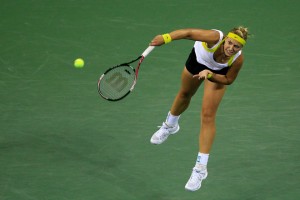It’s one of those repetitive moments in tennis television broadcasting that seem, unfortunately, to persist in your memory.
Dick Enberg, who does an impeccable job on baseball but who, after all these years, has failed to grasp the nuances of tennis, virtually gasping over a break of service in a women’s match.
“Oh my!” he exclaimed for the 1,000th time in TV history, leaving viewers with the feeling that they had just witnessed one of the truly rare moments in tennis.

Those who watch and/or play the game regularly understand that a break in a women’s match seldom constitutes a seminal moment. But here is a chance to quantify just how commonplace a break is in the women’s game. Herewith, the numbers, which I’ve extracted after the first week of play at the U.S. Open.
And what better tournament at which to consider statistics, with the best players entered and trying, at least, to play their best tennis.
Of course you need a benchmark from which to judge breaks in women’s serving, so let’s start with the men, who, taken as a whole for the first seven days of the Open, were holding serve 76.5 percent of time — or about three out of every four games.
The women are holding serve 65.2 percent of the time. This means, as anyone who recalls their high school mathematics knows, that the men are breaking serve only 23.5 percent of the time while the women are being broken 34.8 percent of the time.
This means, on average, that if you have a 12-game set in a women’s match (either 7-5 or 6-6 leading to a tiebreak), there will be 4.2 service breaks. That’s a lot of Oh My moments.
But as long as we’re crunching numbers, let’s not stop there. There’s so much more to ponder in the heady world of statistics.
* Challenges: Neither men nor women have improved, or declined for that matter, when it comes to using the Hawk-eye system to question calls. After a week’s play, the men have been successful 29.55 percent of the time while the women are at 30.88 percent, and that’s not much different than when the system started up several years ago. What this means is hard to say. Some might argue the linespeople and/or chair umpires are right most of the time. Others would argue they’re not right often enough. But that’s why we have the system, isn’t it? Players challenge for various reasons. Sometimes they think the call is wrong. Sometimes they want to break an opponent’s rhythm with a sort of legal stalling tactic. One particularly good thing is happening. The players used to look to the chair umpire for an indication of whether a ball was out or good and the umps would give an opinion. Now, finally, they’re telling the players: “You’ve got challenges and you’re free to use them.” Men are challenging 5.5 times per match to 4.02 for the women, but the men are playing best-of-five while the women are playing best-of-three.
* Aces: Not surprisingly, 6-foot-11 Ivo Karlovic, who lost to Alexandr Dolgopolov in the third round, leads with 74 aces, or 24.7 per match. Big-serving lefty Gilles Muller is second at 21.7. Among the women, Serena Williams (who else?) leads with 26 aces in three matches, or 8.7 per match. Jelena Jankovic is No. 18 among acers for the women with 2.7 per match while the No. 18 man, Jo-Wilfried Tsonga, averages 8.0.
* Serving speed: John Isner and Sergei (Son of Pole Vaulter) Bubka each have swatted a 141 mph shot and, for the record, they only count if the serve is in. Andy Roddick has a 140. On the women’s side, Venus Williams, who withdrew with illness after the first round, has a 126 mph, ahead of Sabine Lisicki (122), who is now out of the tournament.
* Winning points on first serve: Ivan Ljubicic is No. 1, having won 85 percent of his first-serve points, but, obviously, that wasn’t good enough to keep him from losing in the second round to David Nalbandian. Muller also is at 85 percent. For your point of reference, Roger Federer is No. 16 on the list at 77 percent. In the women’s tournament, Serena has won 81 percent of her first serves and has faced only five break points in three matches, successfully defending four of them.
* Winning points on second serve: This says a lot about the effectiveness of one’s second serve and, while Roddick is at 64 percent and that’s no surprise, he trails Kevin Anderson, who has ridden a great kick second serve to 70 percent. Anderson, however, went out in the third round to Mardy Fish. Serena, again, leads the women with 64 percent wins on second-serve points.
* Break-points converted: Very big category and the leader is Tomas Berdych, also out of the tournament with injury. He won 60 percent of his shots at a break, just ahead, so far, of Tsonga (58%). Keep a close watch on young Doglopogov, who went into the Monday matches with a tournament-leading 40 break-point opportunities, converting 55 percent of them. A young man with very happy feet, he gets a lot of balls back into play. Ana Ivanovic leads the women with 73 percent, but Angelique Kerber, a virtual unknown to American audiences, has had a tournament-best 32 break-point chances, converting 63 percent.
That’s quite a testament to Kerber’s game — good enough, in fact, to deserve an Oh My from Mr. Enberg.
